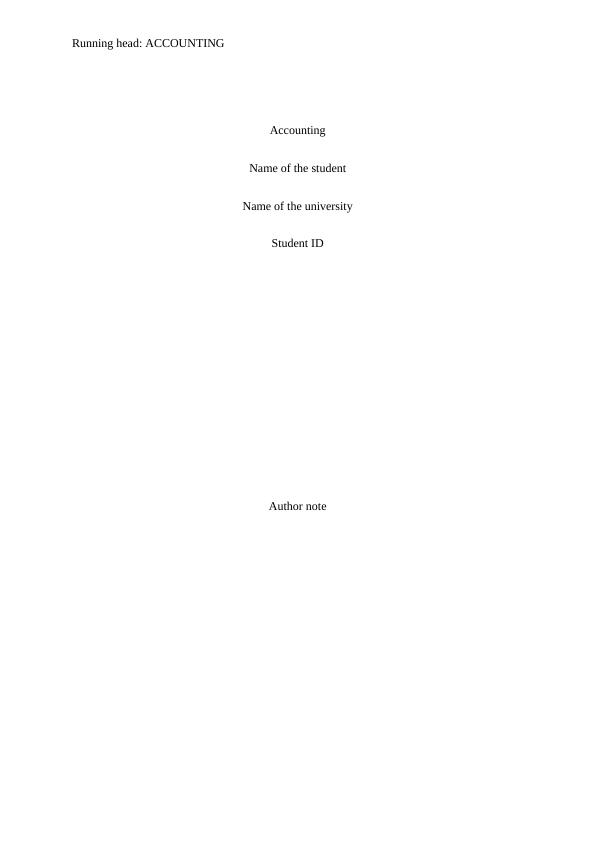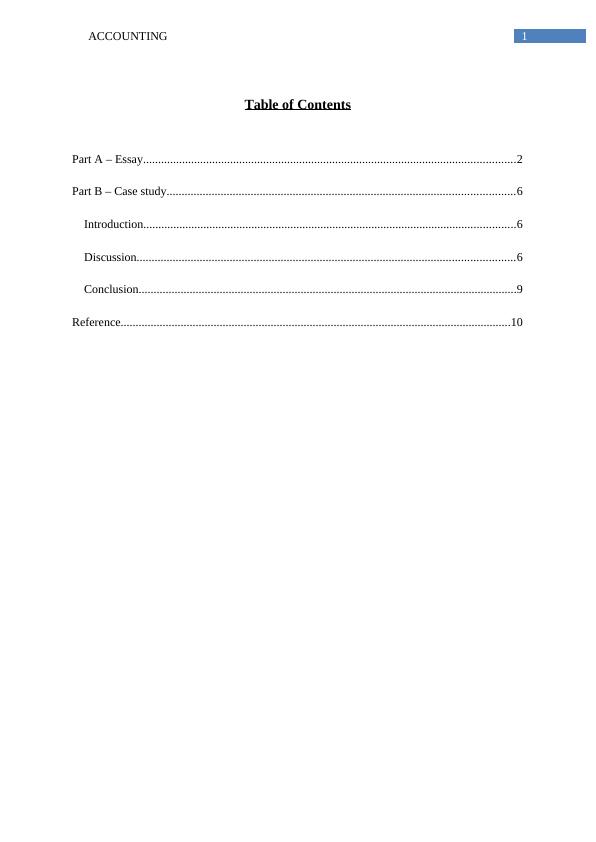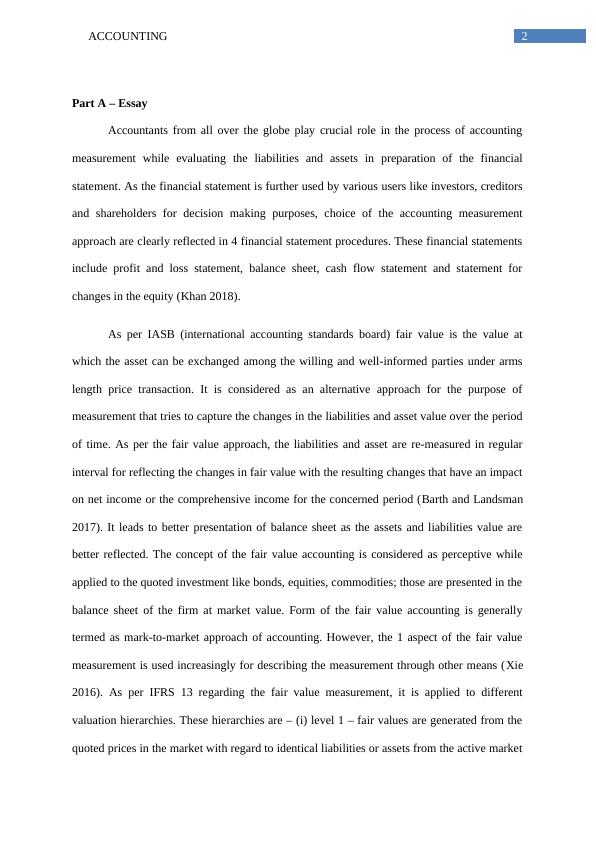Understanding Fair Value Accounting: Importance and Application in Financial Statements
Added on 2023-04-25
13 Pages2813 Words418 Views
Running head: ACCOUNTING
Accounting
Name of the student
Name of the university
Student ID
Author note
Accounting
Name of the student
Name of the university
Student ID
Author note

1ACCOUNTING
Table of Contents
Part A – Essay............................................................................................................................2
Part B – Case study....................................................................................................................6
Introduction............................................................................................................................6
Discussion..............................................................................................................................6
Conclusion..............................................................................................................................9
Reference..................................................................................................................................10
Table of Contents
Part A – Essay............................................................................................................................2
Part B – Case study....................................................................................................................6
Introduction............................................................................................................................6
Discussion..............................................................................................................................6
Conclusion..............................................................................................................................9
Reference..................................................................................................................................10

2ACCOUNTING
Part A – Essay
Accountants from all over the globe play crucial role in the process of accounting
measurement while evaluating the liabilities and assets in preparation of the financial
statement. As the financial statement is further used by various users like investors, creditors
and shareholders for decision making purposes, choice of the accounting measurement
approach are clearly reflected in 4 financial statement procedures. These financial statements
include profit and loss statement, balance sheet, cash flow statement and statement for
changes in the equity (Khan 2018).
As per IASB (international accounting standards board) fair value is the value at
which the asset can be exchanged among the willing and well-informed parties under arms
length price transaction. It is considered as an alternative approach for the purpose of
measurement that tries to capture the changes in the liabilities and asset value over the period
of time. As per the fair value approach, the liabilities and asset are re-measured in regular
interval for reflecting the changes in fair value with the resulting changes that have an impact
on net income or the comprehensive income for the concerned period (Barth and Landsman
2017). It leads to better presentation of balance sheet as the assets and liabilities value are
better reflected. The concept of the fair value accounting is considered as perceptive while
applied to the quoted investment like bonds, equities, commodities; those are presented in the
balance sheet of the firm at market value. Form of the fair value accounting is generally
termed as mark-to-market approach of accounting. However, the 1 aspect of the fair value
measurement is used increasingly for describing the measurement through other means (Xie
2016). As per IFRS 13 regarding the fair value measurement, it is applied to different
valuation hierarchies. These hierarchies are – (i) level 1 – fair values are generated from the
quoted prices in the market with regard to identical liabilities or assets from the active market
Part A – Essay
Accountants from all over the globe play crucial role in the process of accounting
measurement while evaluating the liabilities and assets in preparation of the financial
statement. As the financial statement is further used by various users like investors, creditors
and shareholders for decision making purposes, choice of the accounting measurement
approach are clearly reflected in 4 financial statement procedures. These financial statements
include profit and loss statement, balance sheet, cash flow statement and statement for
changes in the equity (Khan 2018).
As per IASB (international accounting standards board) fair value is the value at
which the asset can be exchanged among the willing and well-informed parties under arms
length price transaction. It is considered as an alternative approach for the purpose of
measurement that tries to capture the changes in the liabilities and asset value over the period
of time. As per the fair value approach, the liabilities and asset are re-measured in regular
interval for reflecting the changes in fair value with the resulting changes that have an impact
on net income or the comprehensive income for the concerned period (Barth and Landsman
2017). It leads to better presentation of balance sheet as the assets and liabilities value are
better reflected. The concept of the fair value accounting is considered as perceptive while
applied to the quoted investment like bonds, equities, commodities; those are presented in the
balance sheet of the firm at market value. Form of the fair value accounting is generally
termed as mark-to-market approach of accounting. However, the 1 aspect of the fair value
measurement is used increasingly for describing the measurement through other means (Xie
2016). As per IFRS 13 regarding the fair value measurement, it is applied to different
valuation hierarchies. These hierarchies are – (i) level 1 – fair values are generated from the
quoted prices in the market with regard to identical liabilities or assets from the active market

3ACCOUNTING
for which the organisation has immediate access (ii) level 2 – where market prices of similar
type of assets are available (iii) level 3 – if the values for level 1 or 2 are not obtainable, fair
value is projected through valuation approaches (Magnan, Menini and Parbonetti 2015).
Most frequently the fair value approach is applied to the financial liabilities as well as
assets as the market prices or the reliable estimates for that are expected to exist for such
elements. It is argued that the fair approach for liabilities and assets reflects the current
market scenario in better way and therefore provides the information in timely manner. On
the other hand, it is argued that the fair values are irrelevant and misleads the users for
different reasons. For instance, some argues that the fair value is irrelevant for the items those
are held for the long term period as the investors are least bothered regarding the changes in
the interim value (Lachmann, Stefani and Wöhrmann 2015). On the other hand, others argue
that the fair values can be distorted through the liquidity problems, market inefficiencies or
the investor’s irrationality and the projected value generated from the models may lack the
reliability. Further, the fair value approach is criticised for its contribution towards pro-
cyclicality in financial system through exacerbating arguments that focus on level 1 as well as
level 2 valuations makes it tough to deviate from the market prices irrespective of when the
prices are lower than the fundamentals or they generate the contagion impacts (Goh et al.
2015).
Under both IFRS as well as US GAAP, the fair value accountings are used most
frequently for assets as well as liabilities. However, for the financial liabilities and assets
mixed attributes are there with multiple stipulated rules that some of the items are recorded at
the fair values and other items are recorded at the historical cost. Further, the unrealized
losses and gains from the items those are reported at the fair values may or may not have an
impact on the net income, based on the classification. For instance, as per FAS 115, that is
implemented in the year 1994, needs that available for sale securities as well as the trading
for which the organisation has immediate access (ii) level 2 – where market prices of similar
type of assets are available (iii) level 3 – if the values for level 1 or 2 are not obtainable, fair
value is projected through valuation approaches (Magnan, Menini and Parbonetti 2015).
Most frequently the fair value approach is applied to the financial liabilities as well as
assets as the market prices or the reliable estimates for that are expected to exist for such
elements. It is argued that the fair approach for liabilities and assets reflects the current
market scenario in better way and therefore provides the information in timely manner. On
the other hand, it is argued that the fair values are irrelevant and misleads the users for
different reasons. For instance, some argues that the fair value is irrelevant for the items those
are held for the long term period as the investors are least bothered regarding the changes in
the interim value (Lachmann, Stefani and Wöhrmann 2015). On the other hand, others argue
that the fair values can be distorted through the liquidity problems, market inefficiencies or
the investor’s irrationality and the projected value generated from the models may lack the
reliability. Further, the fair value approach is criticised for its contribution towards pro-
cyclicality in financial system through exacerbating arguments that focus on level 1 as well as
level 2 valuations makes it tough to deviate from the market prices irrespective of when the
prices are lower than the fundamentals or they generate the contagion impacts (Goh et al.
2015).
Under both IFRS as well as US GAAP, the fair value accountings are used most
frequently for assets as well as liabilities. However, for the financial liabilities and assets
mixed attributes are there with multiple stipulated rules that some of the items are recorded at
the fair values and other items are recorded at the historical cost. Further, the unrealized
losses and gains from the items those are reported at the fair values may or may not have an
impact on the net income, based on the classification. For instance, as per FAS 115, that is
implemented in the year 1994, needs that available for sale securities as well as the trading

End of preview
Want to access all the pages? Upload your documents or become a member.
Related Documents
Pros and Cons of Fair Value Accounting in Financial Reportinglg...
|8
|1939
|381
Assignment Advance Financial Accountinglg...
|7
|1204
|78
The Relevance of the Fair Value Accounting in the Contemporary Worldlg...
|10
|2523
|149
Adoption of Fair Value Method in Abundant Produce Limited and Angel Seafood Limitedlg...
|5
|554
|382
(Sample) Management Accounting Assignmentlg...
|8
|1807
|30
Role of Mark to Market Accounting Approach in Enron’s falllg...
|10
|2630
|138
